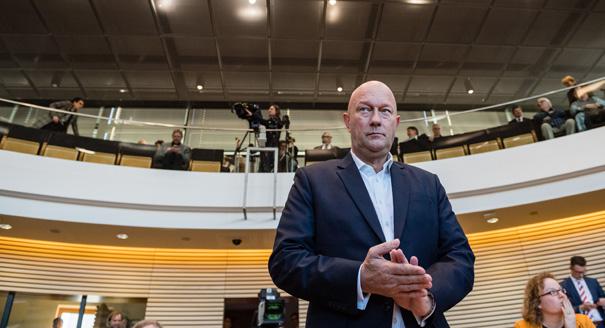What has happened in German politics was considered impossible, but was in fact inevitable. Earlier this month, the federal state of Thuringia elected a new state premier: Thomas Kemmerich, the candidate for the pro-business Free Democratic Party (FDP). The only problem was how he was elected. He had the backing of the center-right Christian Democratic Union (CDU), but what really swung the vote in his favor was support from the far-right Alternative for Germany party (AfD). Those parties had chosen to support the FDP candidate in order to unseat the leftist incumbent Bodo Ramelow.
This apparent joining of mainstream and far-right forces prompted outrage, and people took to the streets to protest against what they saw as liberals becoming complicit in the resurrection of Nazism. It didn’t help that the AfD branch in Thuringia is considered to be its most extreme. Kemmerich was forced to resign a day after his election, amid calls for new elections.
The problem is that new elections may not resolve the situation. Indeed, they may make it worse: the parties to benefit from the outcry will be the two extremes, AfD and the Left Party.
What is happening in Germany is of far more than regional or even national importance. It was clear even back at the start of the 2000s, when far-right parties started gaining in popularity in Europe (first in Austria, where the Freedom Party entered government in 2000, and then in France, where Jean-Marie Le Pen made it through to the second round of the 2002 presidential election), that the time to talk about a major swing in European politics would come when such a party appeared in the Bundestag.
The anti-immigration and Euroskeptic AfD, established in 2013, had a key victory in 2017, when it won about 13 percent of the vote in federal elections, making it the country’s third biggest political force, after the CDU and Social Democratic Party. Those two parties eventually formed a grand coalition at the federal level, and agreed never to enter into any kind of relationship with the AfD, though the nationalist party increased its share of the vote in regional parliament elections across the country.
What’s happening in Germany is not unique to that country: mainstream parties are losing ground all over Europe as the structure of society changes and more and more people feel that none of the usual parties represent them. The domination of centrism as a response to the ideological battles of the Cold War meant that parties had become almost indistinguishable from one another, leading voters to feel that there was no real choice.
The fragmentation of the political landscape, which is unavoidable as the large parties wane, means it has become much harder to form sturdy coalitions. Attempts to escape this deadlock through new elections will either produce the same result, or an even worse one (as Israel, Spain, and many other countries have recently shown).
Accordingly, what happened in Thuringia will be seen elsewhere, too. The far right has too big a presence in Germany (and several other EU states: Italy, Austria, and now Sweden. too) for it to simply be ignored, despite impassioned pleas against the socialization of xenophobic forces.
Germany is beginning a very complex transformation period, and this will inevitably lead to the transformation of the EU as a whole. European integration was born out of the need to bring Germany—the source of war and upheaval for many decades—into a larger structure, to avoid further cataclysms. As Germany grew, first economically and then politically, the EU was what kept in check the fears of Germany’s neighbors with regard to its outsized influence.
The debt crisis of 2010–2013, the migrant crisis of 2015, the need to react to Brexit in 2016, and the United States’ changed rhetoric under President Donald Trump all rocked the EU, but Germany—and particularly Chancellor Angela Merkel—were still seen as the only possible leader of change.
Today, as Germany faces its own challenges, Merkel is preparing to step down, and is no longer seen as the architect of a future Europe. At the same time, the relationship between various powers in the EU is changing. The withdrawal from the EU of the UK, which had acted as a necessary counterbalance to the continent on many issues, creates the need for a new balance between major countries, above all Germany and France, which have different ideas about how the EU should be developing.
The momentum for disintegration within the EU is exacerbating Germany’s fears of once again being left alone with its inner demons and neighbors’ troubles. There is little cause to expect that AfD will become a leading political force: historical constraints are still in place, and the far right is still lacking in political skill. Yet the political landscape will inevitably take on a different form, as Merkel-era centrism gives way to growing ideological polarization. People across Europe want to see clear views from politicians that correspond to their needs and demands. They could be divided into progressives and national conservatives.
The Europe conceived after the disasters and suffering of the first half of the twentieth century is coming to an end. This is primarily because the conditions that enabled it to exist (both external, such as the Cold War, and internal, such as a clear societal structure) are no longer in place. The vaccine against the maladies that led to the tragedies of the twentieth century had been considered indefinite, but there are more and more signs that that vaccine has an expiry date. European harmony is giving way to uncertainty, and as was always the case in the Old World, these changes will not pass without upheaval.
This material is part of the Russia-EU: Promoting Informed Dialogue project, supported by the EU Delegation to Russia.
